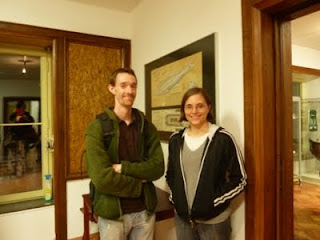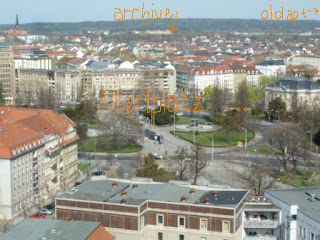 I have been accumulating cultural experiences from the last couple of months, and now I think I have a clever little rhetoric for putting them together. I’ll describe what I saw one sunny day in Dresden and then what I did during the recent Museumsnacht (Museum Night) in Leipzig.
I have been accumulating cultural experiences from the last couple of months, and now I think I have a clever little rhetoric for putting them together. I’ll describe what I saw one sunny day in Dresden and then what I did during the recent Museumsnacht (Museum Night) in Leipzig.
The first weekend in April, on a really beautiful Sunday afternoon, I decided to walk ~45 minutes home from the swim hall where I had done a few laps after church. As I meandered through the Innere Neustadt, I noticed several sandwich boards outside the Dreikönigskirche (Church of the Three Kings). I had heard that the view from their bell tower is the best in the city, so I decided to investigate.
I didn’t get further than the lobby, however, because there some sort of special service was being conducted in the sanctuary. But that was okay, as this evangelisch (Protestant) church is apparently quite active in matters of social justice: there was a exhibit of art from Columbia sponsored by Amnesty International related to the on-going drug war. Apparently, when the country formed in the early 1800s, the landed class demanded a strong central government, while the urban bourgeoisie feared their power and wanted a weaker one. A century later (post-WWII), the resulting relatively weak central government was not able to stop the landowners from mistreating the peasants, who formed paramilitary groups in self-defense. These have since abandoned their Robin-Hood past of sticking up for the common people and are just as guilty of terrorizing the peaceful, law-abiding populace as the cocaine guerillas, who are fighting the (US-backed) military. I found the art pieces about living amid all this violence to be very moving.
After that I asked about the bell tower, which I was able to reach by going around outside. While reading about the history of the church building—destroyed during the 1945 firebombing—the clock struck three, and the bells’ peals drove a flock of teenagers clattering down the steps! I climbed up I-can’t-remember-how-many steps by myself and emerged to a brisk breeze and strong sunshine. Here are just two pictures, one looking south to the Altstadt (where I lived), and one looking north over the Neustadt to Albertstadt and the Main State Archive where I spent most of my waking/working hours.
 |
| 1—Kunstakademie, 2—Frauenkirche, 3—Kreuzkirche, 4—Kathedrale, 5—Residenzschloss |
Leipzig also has a rich musical history (ever heard of J.S. Bach? what about Felix Mendelssohn? Gustav Mahler? Robert and Clara Schumann??). Norway’s favorite composer attended the conservatory here in the mid-nineteenth century, and he frequently visited throughout his life. In fact, he composed (or at least orchestrated) the Peer Gynt Suite in his fourth-floor apartment of the building that now houses a small museum about him. At 9pm we watched a 20-minute adaptation of Henrik Ibsen’s Peer Gynt play by a high school theater group from outside Chemnitz, complete with snippets from Grieg’s music. The actresses were very enthusiastic (especially the Mountain King’s minions), and afterwards they served us a dessert called Abandoned Bride (crumbled graham crackers, apple sauce, and quark (kind of like whipped cream)). I hadn’t known the story before, and I learned a little about Grieg (who had a happy marriage to his cousin and who apparently carried a little stone frog in his pocket as a good luck charm before concerts).
Last on our agenda was the little Psychiatry History Museum, because there was supposed to be a reading of creepy storied by a bonfire. On our way, we biked past the Hinrichtungstätte, the Stasi execution site during the DDR that is only open once a year, on Museumsnacht. 64 people were killed, most on what were probably trumped-up charges. The line to get in was out the door, but we were heading for the hip locale of Karl-Liebknecht-Strasse and pizza anyway. After sitting outside and people-watching while enjoying our drinks and munchies, it was time to hop back on our bicycles and look for the bonfire.
We arrived a little after 11pm to find a large fire, people chatting, and one woman holding a small book up to candle lantern and reading in what sounded like a desultory way. But we couldn’t tell for sure, because only the people sitting at the picnic table with her could hear, which was disappointing. She wasn’t projecting her voice at all. After a few minutes of straining we gave up and went inside and upstairs to see the exhibits. This cool little museum is exactly what you would want in a history of psychiatry museum: it devotes significant space to telling individual patients’ stories; it acknowledges psychiatry’s terrible history (such as the T4 massacres of disabled and chronically ill individuals that took place in 1939/40); and a side exhibit challenges the dependence of contemporary psychiatry on the pharmaceutical industry. There was also an exhibition of humanizing portraits of people we think are current psychiatric clients in town. One small room is given over to Daniel Paul Schreber, son of the man who founded the Schrebergarten movement (Germany’s famous little gardening colonies) and famous himself for having written an autobiography of his mental illness that Freud read and turned into a case study on repressed homosexuality. I found out that the park by my apartment is named for Lene Voigt, who in the 1920s was famous for her poetry in Säschisch, the difficult Saxon dialect. Because the Nazis found her style "ugly," she had a hard time publishing in the 1930s; in the early 1940s she was diagnosed with late-onset schizophrenia and institutionalized until her death in 1962. They also tell the life story of a man, also possibly schizophrenic, who was tried, appealed, and eventually hung in 1820-something for murdering his on-again, off-again girlfriend. His was the last public execution in Leipzig.
 |
| In front of some technical drawings by a patient during the DDR whose favorite topic was space and travel. |
We hung out by the fire until 1am, when everything was supposed to close down. But the guy in charge of the fire was still feeding it branches, so I guess they let people in until 1am, and then you could stay until the fire died, which was going to be another while. But we three biked home our separate ways. My way was very separate, for I turned too soon and got briefly lost. A big problem for me here is the street names. Have I mentioned that Leipzig has a lot of history? Well, I meant to turn down [insert famous person’s name here]-Strasse, but instead I went down [insert famous person’s name here]-Strasse. Unlike other cities, where a [insert famous person’s name here]-Strasse stands out because it’s different from the streets with ordinary names (like Prager Strasse or Schützenplatz), Leipzig seems to have a lot of them. Many Dresden street signs had plaques explaining for whom the street was named—maybe Leipzig just has more more-famous people streets for me to get confused? It also doesn't help that the streets frequently change names. At any rate, I saw even more of Leipzig by night than I had bargained on!



No comments:
Post a Comment
Your comments let me know that I am not just releasing these thoughts into the Ether...